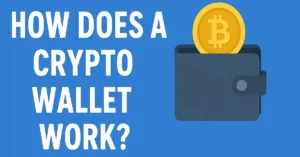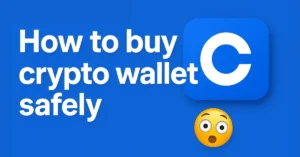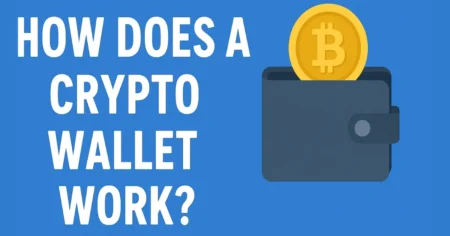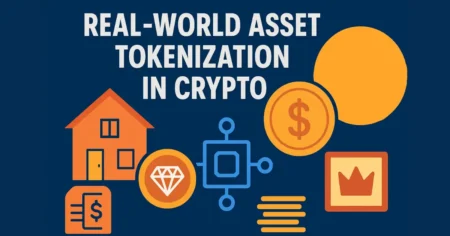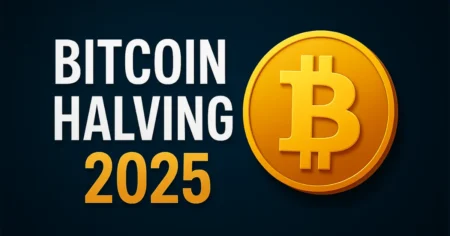Cryptocurrency for beginners
Introduction to Cryptocurrency
What is Cryptocurrency?
Cryptocurrency is digital money. It’s designed to work as a medium of exchange through a decentralized network. Unlike traditional currencies issued by governments (like the US dollar or Euro), cryptocurrencies are based on blockchain technology — a transparent, secure, and public ledger system that records all transactions. What makes crypto fascinating is that it doesn’t need banks or middlemen to operate. It’s a peer-to-peer system.
You’ve probably heard names like Bitcoin, Ethereum, or maybe even Dogecoin. But all of these are just different types of cryptocurrency. They’re often used for investment, online purchases, or even sending money internationally.
Here’s a simple way to think about it: imagine if your online money—like the balance in your PayPal account—wasn’t controlled by any company. Instead, it was held in a digital wallet you owned and operated on a network that anyone could use, but no single person controlled. That’s cryptocurrency in a nutshell.
Most cryptocurrencies are limited in supply. Bitcoin, for instance, has a cap of 21 million coins. That scarcity creates value, similar to how gold works.
Still confused? Don’t worry. It gets clearer the more you learn and engage with it.
The Origin and Evolution of Cryptocurrency
Cryptocurrency didn’t pop up overnight. Its roots go back decades, when computer scientists were trying to create a form of digital money. But it wasn’t until 2009 that the first real cryptocurrency was launched — Bitcoin, created by the mysterious figure Satoshi Nakamoto.
Bitcoin was revolutionary. It proved that decentralized digital money could work, and it sparked an entire industry. In the early days, Bitcoin was mainly used by tech enthusiasts, libertarians, and people who valued privacy. Fast-forward to today, and it’s a global phenomenon with trillions of dollars in market capitalization.
Since Bitcoin, thousands of other cryptocurrencies have emerged. Ethereum introduced smart contracts, allowing apps to run on the blockchain. Then came tokens for gaming, decentralized finance (DeFi), non-fungible tokens (NFTs), and even meme coins like Dogecoin.
The evolution of crypto shows how fast the technology world can move. What started as a tiny rebellion against banks has now become a financial frontier that governments and corporations are paying close attention to.
Why Cryptocurrency Matters Today
Let’s face it — the world is changing fast, and traditional financial systems aren’t keeping up. Cross-border payments take days. Banks close at night. Fees are high. Crypto solves many of these problems.
With crypto, you can send money anywhere in the world in minutes, sometimes seconds. There’s no need for a bank account. All you need is an internet connection and a crypto wallet. This opens doors for millions of unbanked people in developing countries.
Also, crypto offers people a hedge against inflation. In countries where national currencies are losing value rapidly, Bitcoin and stablecoins offer a more stable alternative. People in Venezuela, Turkey, and Argentina are already relying on crypto as a financial lifeline.
And let’s not forget transparency. Every transaction on most blockchains is publicly visible. That means less fraud and more accountability. Governments and big companies are even experimenting with blockchain to improve voting systems, supply chains, and digital identity.
So, why does crypto matter today? Because it’s not just digital money. It’s a new way to think about money, power, and trust.
How Cryptocurrency Works
The Role of Blockchain Technology
If cryptocurrency is the car, then blockchain is the engine. It’s what makes everything run.
A blockchain is a digital ledger — a record of transactions. Imagine a notebook that everyone can see, but no one can erase. Every time someone sends or receives cryptocurrency, that transaction is added to a “block.” Once the block is full, it gets linked to the previous block, forming a chain. That’s the blockchain.
What makes blockchain powerful is decentralization. Instead of one server storing the ledger (like your bank does), thousands of computers around the world store identical copies. These are called nodes. If one node goes down, the others keep running. No single entity can alter the blockchain without the consensus of others.
This structure ensures security, transparency, and trust. You don’t need to trust a bank. You just trust the math, the code, and the network.
Blockchains also come in different types:
- Public blockchains (like Bitcoin) are open to everyone.
- Private blockchains are restricted and often used by companies.
- Hybrid models combine both features.
And remember: not all blockchains are created equal. Some are faster, cheaper, or more eco-friendly. But they all serve the same purpose — to support decentralized digital systems.
Mining and Consensus Mechanisms
You might have heard that Bitcoin needs to be “mined.” But no, it’s not like digging for gold. Crypto mining is the process of verifying transactions and adding them to the blockchain. Miners compete to solve complex math problems, and the winner gets to add the next block. In return, they earn rewards — usually in the form of coins.
This process is called Proof of Work (Po, W), and it’s what Bitcoin uses. It’s secure, but it’s energy-intensive.
To fix that, some newer cryptocurrencies use Proof of Stake (PoS). Instead of competing, users “stake” their coins to be randomly chosen to validate blocks. It’s faster, cheaper, and much more energy-efficient.
There are other consensus models too — Delegated Proof of Stake, Proof of Authority, etc. But the goal is the same: to ensure that everyone agrees on the state of the blockchain without needing a central authority.
So when you hear people talk about mining or staking, they’re talking about how a crypto network reaches agreement and stays secure.
Popular Cryptocurrencies to Know
Bitcoin (BTC) – The Pioneer
Bitcoin is where it all started. It’s the first and most well-known cryptocurrency. Launched in 2009 by an anonymous creator known as Satoshi Nakamoto, Bitcoin introduced the concept of decentralized digital money to the world.
Why is Bitcoin so important? First, it’s the most valuable cryptocurrency by market cap. It’s often referred to as “digital gold” because, like gold, Bitcoin has a limited supply — only 21 million will ever exist. This built-in scarcity has contributed to its increasing value over time.
But Bitcoin isn’t just valuable because it’s rare. It’s also incredibly secure. Its network is backed by thousands of nodes and miners worldwide, making it extremely difficult to hack or manipulate. Plus, its simple, predictable system (a new block every 10 minutes) makes it reliable and transparent.
Bitcoin’s main use today is as a store of value. It’s a favorite among investors looking for a hedge against inflation or financial instability. It’s also used for international transfers, especially in countries with unstable banking systems.
Still, Bitcoin isn’t perfect. Transactions can be slow and costly during network congestion. It doesn’t support smart contracts or complex applications like newer coins do. But its reputation, security, and decentralized nature keep it at the top of the crypto pyramid.
Ethereum (ETH) – Smart Contracts and dApps
If Bitcoin is digital gold, Ethereum is the decentralized internet. Created by Vitalik Buterin and launched in 2015, Ethereum introduced a groundbreaking idea: smart contracts.
Smart contracts are self-executing agreements written into code. They don’t need lawyers or middlemen. When specific conditions are met, the contract automatically runs. This innovation allows developers to build decentralized applications (dApps) — like DeFi platforms, games, NFT marketplaces, and more.
Ethereum is much more than a currency. It’s a platform. It has fueled an entire ecosystem of projects, from Uniswap to OpenSea, reshaping industries like finance, art, and real estate.
However, Ethereum has faced scalability issues. At peak times, gas fees (transaction costs) can skyrocket. That’s why the Ethereum network is undergoing upgrades — including the move to Ethereum 2.0, which uses Proof of Stake and promises faster, cheaper transactions with less energy use.
If you’re interested in crypto beyond just buying and holding, Ethereum is a must-know. It’s where innovation happens.
Other Noteworthy Coins (Solana, Cardano, Ripple, etc.)
Beyond Bitcoin and Ethereum, the crypto world is packed with interesting and promising coins. Here are a few you should know:
- Solana (SOL): Known for its speed and low fees, Solana is popular among developers building DeFi apps and NFTs. It can handle thousands of transactions per second, making it a strong Ethereum competitor.
- Cardano (ADA): Created by one of Ethereum’s co-founders, Cardano is built with a research-based approach. It focuses on scalability, sustainability, and real-world use cases, especially in education and healthcare.
- Ripple (XRP): Ripple is designed for fast, low-cost cross-border payments. It’s used by banks and financial institutions. Though it’s been involved in legal disputes with the SEC, it remains one of the top cryptocurrencies by market cap.
- Polkadot (DOT): Aims to connect different blockchains, enabling them to work together. It’s all about interoperability and scalability.
- Chainlink (LINK): Provides real-world data to smart contracts. Think of it as the “Oracle” layer for blockchains.
Exploring these coins gives you a broader view of the crypto landscape. Each one has a unique purpose, community, and use case. If you’re planning to invest or dive deeper into crypto, learning about these projects is essential.
Setting Up to Use Cryptocurrency
Choosing the Right Wallet
To interact with cryptocurrency, you need a wallet. But unlike a physical wallet that holds cash, a crypto wallet stores your private keys — the secret code that allows you to access and spend your crypto.
There are two main types of wallets:
- Hot wallets: These are connected to the internet. Examples include mobile apps, desktop apps, or web-based wallets like MetaMask or Trust Wallet. They’re convenient for daily use but more vulnerable to hacks.
- Cold wallets: These are offline wallets, like hardware devices (Ledger, Trezor) or paper wallets. They’re far more secure but less convenient for frequent transactions.
When choosing a wallet, consider your needs. Are you a casual user who wants quick access to crypto for small purchases? A hot wallet might do. But if you’re storing a significant amount, go with a cold wallet for maximum security.
Also, remember:
Always back up your seed phrase — the set of 12–24 words that can recover your wallet. Write it down and store it safely offline.
- Never share your private keys or seed phrase with anyone.
- Keep software up to date to avoid vulnerabilities.
Choosing the right wallet is like choosing a bank. It’s your first line of defense against theft and loss.
Crypto Exchanges – Where to Buy and Sell
You’ve got your wallet. Now, how do you get some crypto? That’s where exchanges come in.
A cryptocurrency exchange is a platform where you can buy, sell, or trade cryptocurrencies using fiat money (like USD or EUR) or other cryptos. There are two types:
- Centralized exchanges (CEX): Think Coinbase, Binance, Kraken. These are user-friendly, have high liquidity, and support fiat payments. However, they hold your private keys — meaning you don’t fully “own” your crypto unless you withdraw to a personal wallet.
- Decentralized exchanges (DEX): Examples include Uniswap, PancakeSwap, or SushiSwap. These let you trade directly from your wallet, without intermediaries. You retain full control of your funds but need to understand how to use them safely.
Here are tips for using exchanges:
- Use a reputable exchange with strong security and transparent policies.
- Enable 2FA (Two-Factor Authentication) for extra security.
- Start small and test the platform before making large trades.
- Withdraw your assets to a private wallet if you’re not trading regularly.
Don’t just chase low fees or fancy apps. Choose platforms that prioritize user safety and regulatory compliance.
Investing in Cryptocurrency Safely
Understanding Volatility and Risk
If you’re planning to invest in cryptocurrency, the first thing you need to know is this: crypto is highly volatile. Prices can skyrocket one day and plunge the next. For example, Bitcoin has seen swings of 20% or more in just a few hours. That kind of movement is both exciting and terrifying.
So, why is crypto so volatile?
- Speculation: A lot of people invest based on hype or news, causing massive buy/sell activity.
- Low liquidity: Compared to traditional markets, crypto is still relatively small. That means big trades can cause large price shifts.
- Regulatory news: Any announcement from governments—good or bad—can influence the market heavily.
- Technology bugs or hacks: When a project has technical issues or gets exploited, the value can drop instantly.
Before you invest, ask yourself:
- Can I afford to lose this money?
- Do I understand what I’m buying?
- Am I chasing a trend or making an informed decision?
Managing risk is essential:
- Only invest what you can afford to lose.
- Don’t put all your money into one coin.
- Avoid panic buying or selling.
Treat crypto as part of a balanced financial plan, not a get-rich-quick scheme. The key is patience, research, and discipline.
Long-Term vs. Short-Term Investment
Once you’ve decided to invest, the next big question is: are you in it for the long haul or the quick trade?
Long-term investing, or HODLing (a term born from a misspelled “hold”), means buying a cryptocurrency and holding it regardless of market fluctuations. This strategy is common among Bitcoin and Ethereum investors who believe in the long-term growth of the technology.
Short-term trading, on the other hand, involves buying and selling quickly to take advantage of price swings. This could be day trading, swing trading, or scalping.
Here are the pros and cons:
| Strategy | Pros | Cons |
|---|---|---|
| Long-Term | Less stress, lower fees, tax advantages | Slower gains, missed opportunities |
| Short-Term | Potential quick profits | High risk, time-consuming, stressful |
For beginners, long-term investing is usually safer. You don’t need to watch the market 24/7. Just buy quality projects, store them securely, and let time do the work.
But if you do want to trade short-term, learn technical analysis, use stop-loss orders, and never trade with emotions.
Diversification and Portfolio Tips
One of the golden rules of investing is: don’t put all your eggs in one basket. In crypto, this is more important than ever.
Diversifying your crypto portfolio means spreading your investments across different coins and sectors. For instance:
- Hold a core in Bitcoin and Ethereum — they’re the most stable and widely adopted.
- Allocate a smaller portion to altcoins like Solana, Polkadot, or Avalanche.
- Consider emerging sectors like DeFi, NFTs, and Layer 2 solutions.
Some helpful portfolio strategies:
- 80/20 Rule: 80% in major coins, 20% in riskier altcoins.
- Rebalance monthly to maintain your target ratios.
- Track your holdings with tools like CoinGecko or Blockfolio.
Don’t forget:
- Watch for correlation. Many altcoins follow Bitcoin’s movements, so your portfolio might not be as diverse as you think.
- Stay updated with project developments. A coin you bought last year might be obsolete today.
- Ultimately, your portfolio should reflect your risk tolerance, goals, and time horizon.
Using Cryptocurrency for Transactions
Everyday Uses – Shopping, Bills, Transfers
Crypto isn’t just for investing—it’s also money you can use. Today, you can:
- Buy gift cards with crypto for stores like Amazon, Walmart, and Starbucks.
- Pay bills through services that accept Bitcoin or stablecoins.
- Shop online from websites like Overstock or Newegg.
Travel using platforms like Travala, which lets you book hotels and flights with crypto.
And it’s growing. Major brands are beginning to integrate crypto payments, either directly or through third-party services like BitPay or Coinbase Commerce.
That said, crypto’s use in everyday life depends on where you live. Some countries are more open and integrated than others.
When spending crypto:
- Consider transaction fees—they vary by network.
- Remember that using crypto is a taxable event in many countries.
- Stick with stablecoins for regular expenses if you want price stability.
Crypto is becoming more useful every day, especially in countries with unstable currencies or poor banking infrastructure.
Peer-to-Peer Payments and International Transfers
One of crypto’s best features is fast, cheap, borderless transactions. Traditional money transfers can be slow and expensive, especially across countries. Crypto fixes that.
With a crypto wallet and a recipient’s wallet address, you can send funds in minutes. No need for bank approvals, exchange rates, or waiting periods.
Benefits of P2P crypto payments:
- Lower fees than Western Union or PayPal.
- Faster—sometimes within seconds.
- No middlemen—just you and the other party.
People are using crypto to:
- Send remittances to family abroad.
- Pay freelancers or remote workers.
- Settle bills among friends or groups.
Apps like Strike and the Lightning Network are even making it possible to send Bitcoin instantly with almost no fees.
Still, always verify addresses before sending, and double-check the network (sending USDT on Ethereum vs. Binance Smart Chain) to avoid mistakes.
Risks and Challenges in Crypto
Scams, Hacks, and How to Stay Safe
Crypto offers huge potential—but it’s also full of traps for beginners. From phishing scams to rug pulls, this space can be dangerous if you’re not careful.
Common crypto scams include:
- Phishing attacks: Fake websites or emails that steal your login info or private keys.
- Rug pulls: Developers hype up a token, raise money, then disappear with the funds.
- Pump-and-dump schemes: Coordinated efforts to inflate a coin’s price, only to sell off and crash it.
- Fake airdrops: Promises of free tokens that trick you into connecting your wallet to malicious sites.
To protect yourself:
- Never share your private key or seed phrase.
- Bookmark official websites for wallets and exchanges.
- Double-check URLs and email addresses.
- Use hardware wallets for long-term storage.
- Do your research (DYOR) before buying any token.
Crypto isn’t like banks—if you make a mistake or get scammed, there’s usually no way to get your money back. That’s why caution is your best defense.
Regulatory Uncertainty
One of the biggest question marks in crypto is regulation. Different countries treat it very differently:
- El Salvador: Made Bitcoin legal tender.
- USA: Taxed as property; regulatory bodies like the SEC are cracking down on some tokens.
- China: Banned crypto transactions entirely.
- EU and UK: Implementing licensing and AML (anti-money laundering) laws.
Why does this matter? Because laws affect:
- Which platforms can operate?
- How your crypto is taxed.
- Whether your country allows or restricts crypto usage.
For beginners, it’s important to:
- Understand your country’s crypto regulations.
- Stay updated as laws are constantly evolving.
- Choose exchanges that comply with local laws.
Crypto’s future depends heavily on how governments respond. While regulation can bring safety and legitimacy, too much of it can stifle innovation.
Environmental Concerns and Solutions
Crypto critics often bring up one valid concern: the environmental impact, especially of Proof of Work coins like Bitcoin.
Bitcoin mining uses a lot of electricity. Why? Because miners run powerful computers 24/7 to solve complex puzzles. This has led to concerns about carbon emissions and energy use.
However, the crypto community is working on solutions:
- Proof of Stake (PoS): Uses up to 99% less energy than PoW. Ethereum transitioned to PoS in 2022.
- Green mining initiatives: Some Bitcoin miners now use renewable energy like hydro, wind, or solar.
- Layer 2 solutions, like the Lightning Network, reduce the energy per transaction.
As a beginner, be mindful of the projects you support. Look for those that prioritize sustainability or are actively reducing their environmental impact.
Taxation and Legal Aspects
Reporting Crypto on Taxes
In many countries, cryptocurrency is subject to taxation—even if you didn’t sell for cash.
Here’s how most governments tax crypto:
- Capital Gains Tax: If you bought low and sold high, you owe tax on the profit.
- Income Tax: If you received crypto for work or staking rewards, it’s considered income.
- Transaction Tax: Even swapping one token for another might be a taxable event.
To stay compliant:
- Keep track of every trade and transaction.
- Use tools like CoinTracker, Koinly, or Accointing to generate tax reports.
- File your taxes on time and report all crypto activity.
Ignoring crypto taxes can lead to penalties or audits. So even if you’re just dabbling, document everything properly.
Legal Standing in Different Countries
Crypto is global, but every government has its own rules. Here’s a quick snapshot:
| Country | Legal Status |
|---|---|
| USA | Legal, regulated as property |
| Canada | Legal, taxed as income/capital gains |
| UK | Legal, subject to FCA oversight |
| China | Banned crypto trading |
| India | Legal but taxed heavily |
| El Salvador | Legal tender |
Before investing or transacting, research your local laws. Also, watch for news, as many countries are actively developing new legislation.
Staying Compliant and Ethical
Crypto is about freedom—but with freedom comes responsibility. It’s up to users to act ethically and stay within legal boundaries.
Tips to stay compliant:
- Use regulated exchanges where available.
- Don’t hide your earnings—transparency is key.
- Understand KYC (Know Your Customer) and AML (Anti-Money Laundering) policies on platforms.
Ethical behavior helps crypto gain acceptance. The more we use it responsibly, the better the reputation—and the future—of this powerful technology.
Learning and Staying Updated
Best Resources for Beginners
There’s so much information out there, it can be overwhelming. But don’t worry—we’ve got your back. Here are some reliable resources:
- CoinGecko / CoinMarketCap: Track prices, volume, and project info.
- Investopedia: Great for learning finance and crypto basics.
- Binance Academy: Offers free courses and guides.
- YouTube channels: Like Whiteboard Crypto, Coin Bureau, or Finematics.
Start small. Pick one topic a week to learn. As your understanding grows, so will your confidence.
Communities, Forums, and Influencers
Crypto isn’t just tech—it’s a vibrant community. Engaging with others helps you learn, share insights, and avoid mistakes.
Join:
- Reddit: r/CryptoCurrency, r/BitcoinBeginners
- Twitter/X: Follow credible influencers, analysts, and developers.
- Discord / Telegram groups: Great for real-time discussions.
Be cautious of “shillers” who promote coins for profit. Follow people who focus on education and analysis, not hype.
Keeping Up with Trends and News
The crypto world moves fast. What’s hot today could be forgotten tomorrow.
To stay updated:
- Use Google Alerts for crypto topics.
- Subscribe to newsletters like Decrypt Daily, The Block, or CoinDesk.
- Follow project roadmaps on official websites.
By staying informed, you’ll be better equipped to make smart decisions and spot opportunities early.
Future of Cryptocurrency
Potential Developments
Where is crypto headed? The future holds big possibilities:
- Decentralized Finance (DeFi): Could replace traditional banking services.
- Web3: A user-owned internet where data and content aren’t controlled by big tech.
- Tokenization of assets: Real estate, art, and even stocks could be traded on blockchain.
Innovation is happening at lightning speed. We may soon see governments issuing digital currencies (CBDCs) or your favorite game integrating NFTs and crypto rewards.
Integration into Mainstream Finance
Crypto isn’t fringe anymore. Big names are getting involved:
- PayPal, Visa, and Mastercard support crypto transactions.
- Goldman Sachs and Fidelity offer crypto investment options.
- Tesla and Square have bought Bitcoin as part of their treasury.
- As institutions embrace crypto, it gains legitimacy—and potentially, stability.
Opportunities for Innovation
Crypto is still young. If you’re tech-savvy, entrepreneurial, or just curious, there’s room for you to build, contribute, or invest.
Whether it’s coding smart contracts, creating educational content, or launching a Web3 startup, this space rewards creativity and initiative.
Conclusion
Cryptocurrency can be exciting, confusing, and overwhelming—all at the same time. But you don’t need to be a tech expert or financial wizard to get started.
Take your time. Learn the basics. Protect your assets. And always do your research.
Crypto is more than just a buzzword—it’s a movement toward decentralization, transparency, and financial freedom.
Whether you want to invest, build, or just understand what everyone’s talking about, you’re in the right place. The journey starts now.
FAQs
What is the safest way to store cryptocurrency?
Using a hardware wallet like Ledger or Trezor is the safest option. Keep your recovery phrase offline and never share it.
Can I buy crypto with just $10?
Absolutely. Most exchanges allow small purchases. You can start with as little as $1 on platforms like Coinbase or Binance.
What is a stablecoin?
A stablecoin is a cryptocurrency pegged to a stable asset, like the US dollar. Examples include USDT, USDC, and DAI. They’re useful for trading and avoiding volatility.
Is crypto legal everywhere?
No. Some countries like China have banned it, while others like the US and UK allow it with regulations. Always check your local laws.
How do I avoid scams in crypto?
Avoid clicking unknown links, never share your private key, use trusted platforms, and always double-check URLs. Trust your gut—if it feels too good to be true, it probably is.
Also, read
- What is a Crypto Wallet and How Does It Work? – Coinsify
- 10 Crypto Terms Every Beginner Must Know – Coinsify
- What is Blockchain Technology – Complete Guide – Coinsify
- How to Buy Crypto Safely in 2025 – Complete Guide – Coinsify
- Bitcoin vs Ethereum: Key Differences Explained – Complete Guide
- Ultimate Blockchain Glossary: Learn Blockchain Terms Easily
- How to Buy Bitcoin Safely (Complete Beginner’s Guide)
- Top 10 Crypto Wallets for Beginners (2025 Edition)
- What is Cryptocurrency? A Beginner-Friendly Guide (2025)
